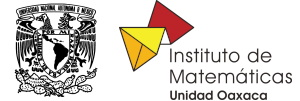Seminarios / Coloquios
Calendario de eventos
Seminario de Categorías
Resumen: Orbifolds are defined like manifolds, by local charts. Where manifold charts are open subsets of Euclidean space, orbifold charts consist of an open subset of Euclidean space with an action by a finite group (thus allowing for local singularities). This affects the way that transitions between charts need to be described, and it is generally rather cumbersome to work with atlases. It has been shown in [Moerdijk-P] that one can represent orbifolds by groupoids internal to the category of manifolds, with etale structure maps and a proper diagonal, I.e., combined source-target map (s,t): G_1 -> G_0 x G_0. We have since generalized this notion further to orbispaces, represented by proper etale groupoids in the category of Hausdorff spaces. Two of these groupoids represent the same orbispace if they are Morita equivalent. However, Morita equivalences are generally not pseudo-invertible in this 2-category, so we consider the bicategory of fractions with respect to Morita equivalences.
For a pair of paracompact locally compact orbigroupoids G and H, with G orbit-compact, we want to study the mapping groupoid [G, H] of arrows and 2-cells in the bicategory of fractions. The question we want to address is how to define a topology on these mapping groupoids to obtain mapping objects for the bicategory of orbispaces. This question was addressed in [Chen], but not in terms of orbigroupoids, and with only partial answers.
We will present the following results:
1. When the orbifold G is compact, we define a topology on [G,H] to obtain a topological groupoid OMap(G, H), which is Morita equivalent to an orbigroupoid. To obtain a Morita equivalent orbigroupoid, we need to restrict ourselves to so-called admissible maps to form AMap(G,H), and Orbispaces(K × G, H) is equivalent to Orbispaces(K, AMap(G, H)).
So AMap(G,H) is an exponential object in the bicategory of orbispaces.
2. We will also show that AMap(G,H) thus defined provides the bicategory of orbit-compact orbispaces with bicategorical enrichment over the bicategory of orbispaces: composition can be given as a generalized map (an arrow in the bicategory of fractions) of orbispaces.
In this talk I will discuss how this work extends the work done by Chen and I will show several examples. This is joint work with Laura Scull.
[Chen] Weimin Chen, On a notion of maps between orbifolds I: function spaces, Communications in Contemporary Mathematics 8 (2006), pp. 569-620.
[Moerdijk-P] I. Moerdijk, D.A. Pronk, Orbifolds, sheaves and groupoids, K-Theory 12 (1997), pp. 3-21.
Contacto: Carlos Segovia
Inscripción en Página:
https://sites.google.com/im.
Youtube:
https://www.youtube.com/watch?v=7Ot9SCJLphU&feature=youtu.be
Avisos / Convocatorias / Noticias
-
Elecciones Consejo Interno investigadoras e investigadores 2025-2028 -Resultados de la votación-
Resultados de la votación llevada a cabo para la elección de una persona representante de investigadoras e investigadores en el Consejo Interno, periodo 2025-2028.
-
Elecciones representante Consejo Interno 2025-2028
En cumplimiento a lo dispuesto en la base séptima de la Convocatoria publicada para la elección de una persona representante de las investigadoras y los investigadores en el consejo interno,
-
ELECCIONES INTERNAS DEL CONSEJO INTERNO.
Elección de una persona representante de investigadoras e investigadores.
-
ELECCIONES INTERNAS 2
Fórmula registrada para la votación de consejeros representante propietario y suplente de las investigadores y los investigadores del Instituto de Matemáticas ante el Consejo Técnico de la Investigación Científica 2025-2029
-
ELECCIONES INTERNAS-Convocatoria
ELECCIONES INTERNAS-Convocatoria para elegir a la consejera o consejero representante propietario y suplente de las personas investigadoras ante el Consejo Técnico de la Investigación Científica, periodo 2025-2029.
-
INTEGRACIÓN CInIG-IMATE
En la pasada sesión del consejo interno de fecha 27 de febrero de 2025, se levantó el acta de conformación de la Comisión Interna para la Igualdad de Género del IMATE, periodo 2025-2027:
-
Lineamientos CINIG
Con base en los Lineamientos generales para guiar la conformación
-
Comunicado: Posgrado Gratuito
Al alumnado del posgrado:
-
¡PREMIOS IMSA 2025 para una matemática y un matemático de nuestro instituto!
¡PREMIOS IMSA 2025 para una matemática y un matemático de nuestro instituto!
“Premio Matemático Joven IMSA - 2025” para Rita Jiménez Rolland, investigadora en la Unidad Oaxaca del IMUNAM.
“Premio Matemático Joven IMSA - 2025” para Alfredo Nájera Chávez, investigador en la Unidad Oaxaca del IMUNAM.







